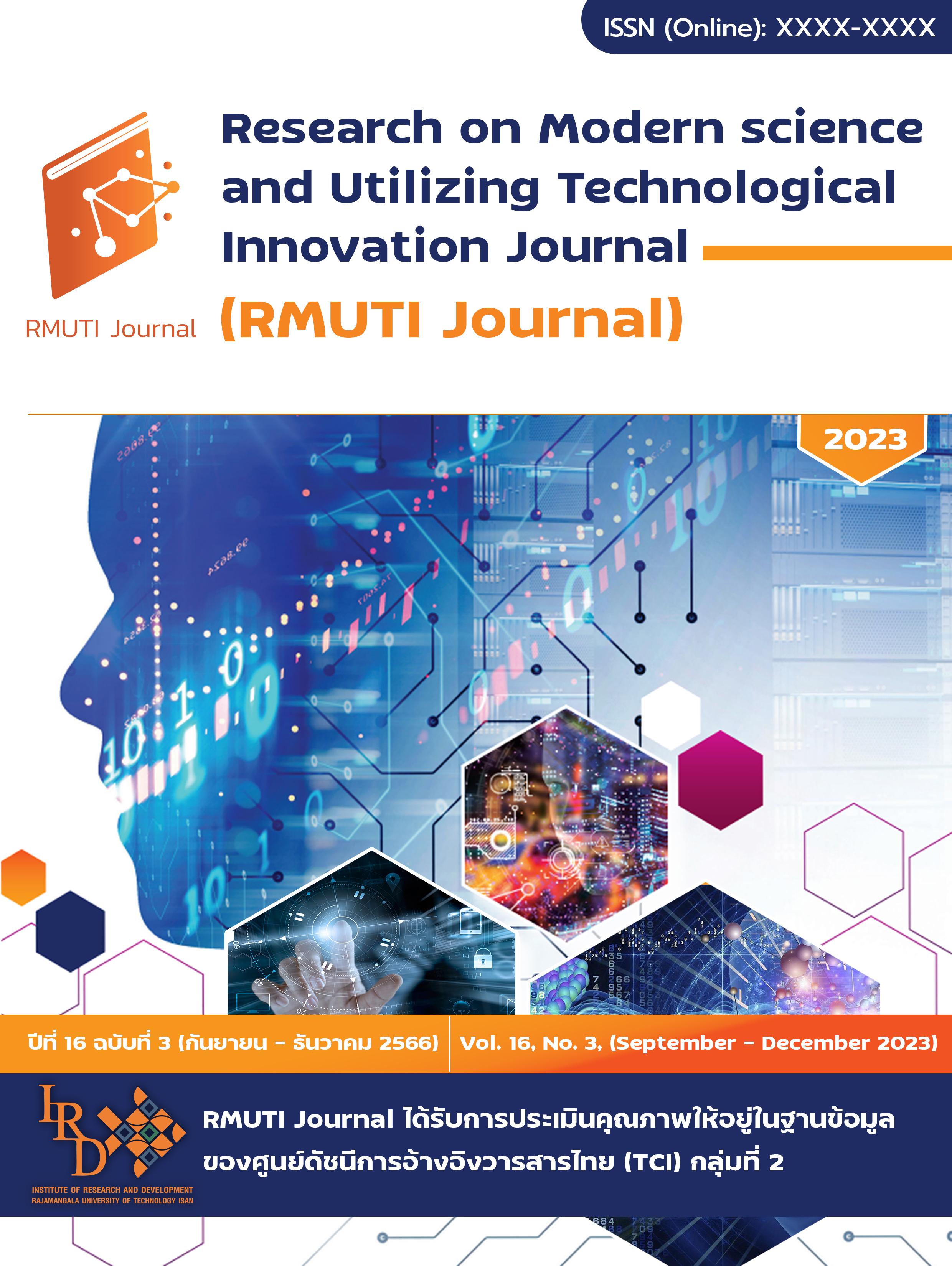Woven Fabric Properties with Different Weave Designs Using Recycled PET Yarns for Portable Chairs
Main Article Content
Abstract
This research aimed to explore the practical use of recycled polyethylene terephthalate yarn (rPET) in technical textiles, extending its application beyond the apparel industry. The specific objective was to produce woven fabrics from rPET yarn for the seats of portable chairs, which are commonly favored for outdoor events. Initially, the process involved twisting 300 denier rPET untwisted yarn into rPET-1 (single-yarn) and rPET-2 (two-ply yarn). Six woven fabrics were then manufactured in three different weave designs (plain, twill, and basket). The warp was rPET-1 at a density of 50 ends per inch, while the weft alternated between rPET-1 and rPET-2, each at 40 picks per inch. The results indicated that fabrics with rPET-2 as the weft exhibited superior tensile and tear strength compared to those employing rPET-1 as the weft. Plain fabrics demonstrated the highest tensile strength, while twill fabrics displayed the highest tear strength. Consequently, these two fabric types were selected to produce the portable chairs, in contrast to the conventional portable chairs constructed with polyester fabric. After subjecting the chairs to a compression test with a load of 150 kgf for 5 cycles, the chair with a plain fabric and rPET-2 as the weft proved the most durable. No damage was found on the seat or frame, and fabric stretching was minimal. In essence, this research underscores the potential of rPET in the durability and sustainability of outdoor seating solutions, while also demonstrating the feasibility of applying this recycled material in technical textile applications.
Article Details

This work is licensed under a Creative Commons Attribution-NonCommercial-NoDerivatives 4.0 International License.
References
Telli, A. and Özdil, N. (2015). Effect of Recycled PET Fibers on the Performance Properties of Knitted Fabrics. Journal of Engineered Fibers and Fabrics. Vol. 10, Issue 2, pp. 47-50
Frost, H., Zambrano, M. C., Leonas, K., Pawlak, J. J., and Venditti, R. A. (2020). Do Recycled Cotton or Polyester Fibers Influence the Shedding Propensity of Fabrics during Laundering? AATCC Journal of Research. Vol. 7, Issue 1_suppl, pp. 32-41. DOI: 10.14504/ajr.7.S1.4
Khan, S. U., Hassan, T., Wasim, M., Khan, M. Q., Salam, A., Hassan, S. Z. U., Abbasi, A. M. R., and Mustafa, T. (2023). Valorization of Recycled PET for Yarn Manufacturing and Knitwear Fabrics used for Apparel Applications. Polymer Bulletin. Vol. 80, Issue 3, pp. 2779-2799. DOI: 10.1007/s00289-022-04172-8
Albini, G., Brunella, V., Placenza, B., Martorana, B., and Guido Lambertini, V. (2019). Comparative Study of Mechanical Characteristics of Recycled PET Fibres for Automobile Seat Cover Application. Journal of Industrial Textiles. Vol. 48, No. 6, pp. 992-1008. DOI: 10.1177/1528083717750887
Bhanderi, K. K., Joshi, J. R., and Patel, J. V. (2023). Recycling of Polyethylene Terephthalate (PET Or PETE) Plastics - An Alternative to Obtain Value Added Products: A Review. Journal of the Indian Chemical Society. Vol. 100, Issue 1, DOI: 10.1016/j.jics.2022.100843
KiriŞ, G. and Yılmaz, D. (2021). The Effect of Recycled Polyester (rPET) Filament Fiber Properties on Various Woven Fabric Performance Properties. Tekstil ve Konfeksiyon. Vol. 31, No. 3, pp. 171-182. DOI: 10.32710/tekstilvekonfeksiyon.767428
Seval, U. (2021). The Bursting Strength Properties of Knitted Fabrics Containing Recycled Polyester Fiber. The Journal of The Textile Institute. Vol. 112, Issue 12, pp. 1998-2003. DOI: 10.1080/00405000.2020.1862490
Majumdar, A., Shukla, S., Singh, A. A., and Arora, S. (2020). Circular Fashion: Properties of Fabrics Made from Mechanically Recycled Poly-Ethylene Terephthalate (PET) Bottles. Resources, Conservation and Recycling. Vol. 161, Article 104915. DOI: 10.1016/j.resconrec.2020.104915
Atakan, R., Sezer, S., and Karakas, H. (2020). Development of Nonwoven Automotive Carpets Made of Recycled PET Fibers with Improved Abrasion Resistance. Journal of Industrial Textiles. Vol. 49, No. 7, pp. 835-857. DOI: 10.1177/1528083718798637
Jahan, I. (2017). Effect of Fabric Structure on the Mechanical Properties of Woven Fabrics. Advance Research in Textile Engineering. Vol. 2, No. 2, DOI: 10.26420/advrestexteng.2017.1018
Kotb, N. A. (2012). Predicting Yarn Quality Performance Based on Fibers types and Yarn Structure. Life Science Journal. Vol. 9, No. 3, pp. 1009-1015
Eryuruk, S. and Kalaoglu, F. (2015). The Effect of Weave Construction on Tear Strength of Woven Fabrics. Autex Research Journal. Vol. 15, No. 3, pp. 207-214. DOI: 10.1515/aut-2015-0004


